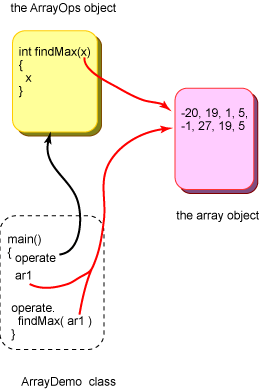Answer:
Just one, created in main().
Just one, created in main().

The picture shows the executing program
just as the findMax() method starts running.
Remember that Java uses call by value to pass data into methods.
With array parameters, this means that the actual parameter in ar1 holds
a reference to the array. This value is copied into the formal parameter x of the method.
There is only one array object,
the one created by main().
When the findMax() method is running it has a reference to
this array in its formal parameter x.
Here are some details:
ArrayDemo is shown in dotted lines because it is a class definition,
not an object.ArrayDemo's static method main() is running.ar1 refers to the array object.operate refers to an ArrayOps object.findMax()
method of operate
is called with ar1 as a parameter.x refers to the
same object as does the variable ar1 in main().
Now the findMax() method runs, using
x to refer to the array it is working with.
When it finishes running, control returns to main().
Usually you do not think about things in such excruciating detail. You would think "call a method to find the maximum" and would write
operate.findMax( ar1 );
But sometimes you really need to know what is going on. Please look the picture over and read over the details a few times. If you rush through this material, you risk missing concepts that are necessary for understanding future topics.
(Test of Understanding Excruciating Detail: )
Could the
main()
method create a second array and use
findMax()
to find its maximum?